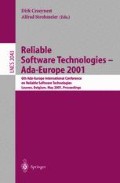Abstract
Test suite reduction is aimed at finding representative sets that can satisfy the same testing objective as their original test suite. As a subset of the original test suite, the representative set may have less fault detection capability. However, researches show that a representative set and its original test suite have similar fault detection capabilities for the case of coverage based criteria. This paper investigates the relationship between the fault detection capabilities of a representative set and its original test suite when the generation of the test suite is based on some fault-based test case selection criteria.
Corresponding author.
Access this chapter
Tax calculation will be finalised at checkout
Purchases are for personal use only
Preview
Unable to display preview. Download preview PDF.
References
T.Y. Chen and M.F. Lau, A new heuristic for test suite reduction, Information and Software Technology, 40(5-6):347–354, 1998.
T.Y. Chen, M.F. Lau, and Y.T. Yu, MUMCUT: A fault-based strategy for testing Boolean specifications, In Proceedings of APSEC’99, pp. 606–613, 1999.
J.J. Chilenski and S.P. Miller, Applicability of modified condition/decision coverage to software testing, Software Engineering Journal, 9(5):193–200, 1994.
R.A. DeMillo, R.J. Lipton, and F.G. Sayward, Hints on test data selection: Help for the practicing programmer, Computer, 11(4):34–41, 1978.
R.A. DeMillo and A.J. Offutt, Constraint-based automatic test data generation, IEEE Trans. on Software Engineering, 17(9):900–910, 1991.
K.A. Foster, Error sensitive test cases analysis (estca), IEEE Trans. on Software Engineering, 6(2):258–264, 1980.
K.A. Foster, Sensitive test data for logic expressions, ACM SIGSOFT Software Engineering Notes, 9(2):120–125, 1984.
D.D. Givone, Introduction to Switching Circuit Theory, McGraw-Hill, 1970.
B. Korel, Automated software test data generation, IEEE Trans. on Software Engineering, 16(8):870–879, 1990.
N.G. Leveson, M.P.E. Heimdahl, H. Hildreth, and J.D. Reese, Requirements specification for process-control systems, IEEE Trans. on Software Engineering, 20(9):684–707, 1994.
G.J. Myers, The Art of Software Testing, John Wiley, Second edition, 1979.
W.V. Quine, The problem of simplifying truth functions, American Mathematical Monthly, 59:521–531, 1952.
C.V. Ramamoorthy, S.-B.F. Ho, and W.T. Chen, On the automated generation of program test data, IEEE Trans. on Software Engineering, 2(4):293–300, 1976.
K.C. Tai, Condition-based software testing strategies, In Proceedings of COMPSAC 90, pp. 564–569, Washington, DC, 1990.
K.C. Tai, Theory of fault-based predicate testing for computer programs, IEEE Trans. on Software Engineering, 22(8):552–563, 1996.
K.C. Tai and H.K. Su, Test generation for boolean expressions, In Proceedings of COMPSAC 87, pp. 278–284, Washington, DC, 1987.
W.T. Tsai, D. Volovik, and T.F. Keefe, Automated test case generation for programs specified by relational algebra queries, IEEE Trans. on Software Engineering, 16(3):316–324, 1990.
E.J. Weyuker, T. Goradia, and A. Singh, Automatically generating test data from a boolean specification, IEEE Trans. on Software Engineering, 20(5):353–363, 1994.
W.E. Wong, J.R. Horgan, S. London, and A.P. Mathur, Effect of test set minimization on fault detection effectiveness, Software-Practice and Experience, 28(4):347–369, 1998.
W.E. Wong, J.R. Horgan, A.P. Mathur, and A. Pasquini, Test set size minimization and fault detection effectiveness: A case study in a space application, The Journal of Systems and Software, 48:79–89, 1999.
Author information
Authors and Affiliations
Editor information
Editors and Affiliations
Rights and permissions
Copyright information
© 2001 Springer-Verlag Berlin Heidelberg
About this paper
Cite this paper
Chen, T.Y., Lau, M.F. (2001). Test Suite Reduction and Fault Detecting Effectiveness: An Empirical Evaluation. In: Craeynest, D., Strohmeier, A. (eds) Reliable SoftwareTechnologies — Ada-Europe 2001. Ada-Europe 2001. Lecture Notes in Computer Science, vol 2043. Springer, Berlin, Heidelberg. https://doi.org/10.1007/3-540-45136-6_20
Download citation
DOI: https://doi.org/10.1007/3-540-45136-6_20
Published:
Publisher Name: Springer, Berlin, Heidelberg
Print ISBN: 978-3-540-42123-8
Online ISBN: 978-3-540-45136-5
eBook Packages: Springer Book Archive

